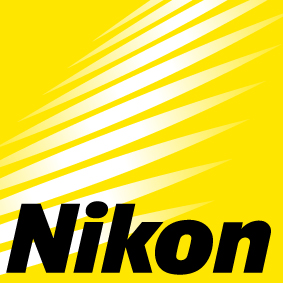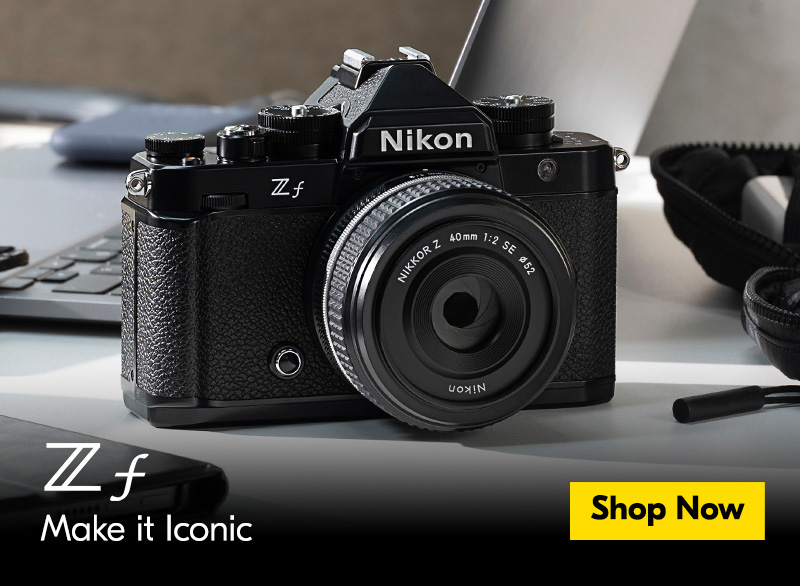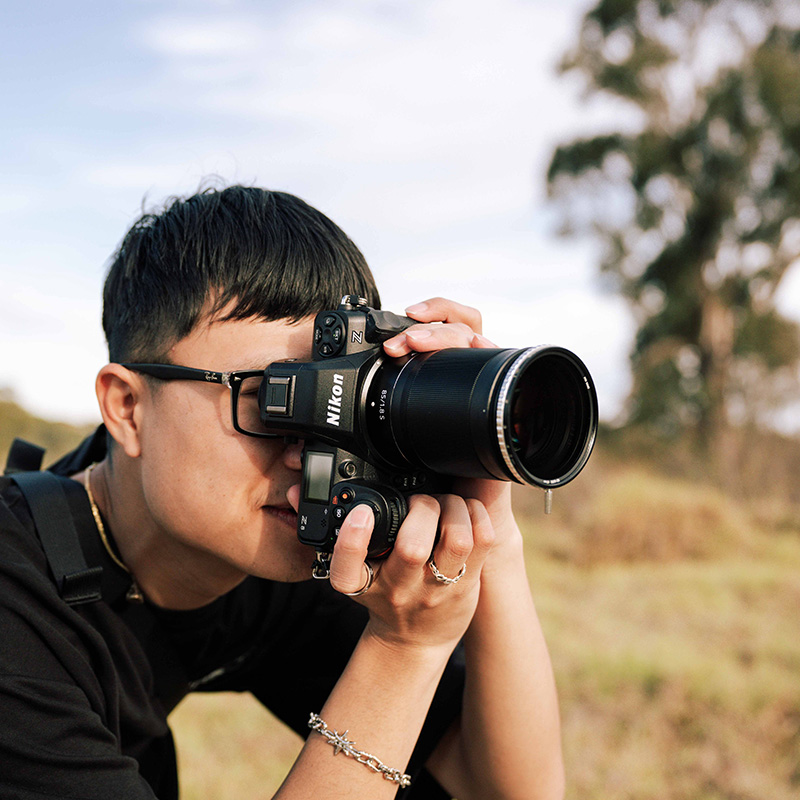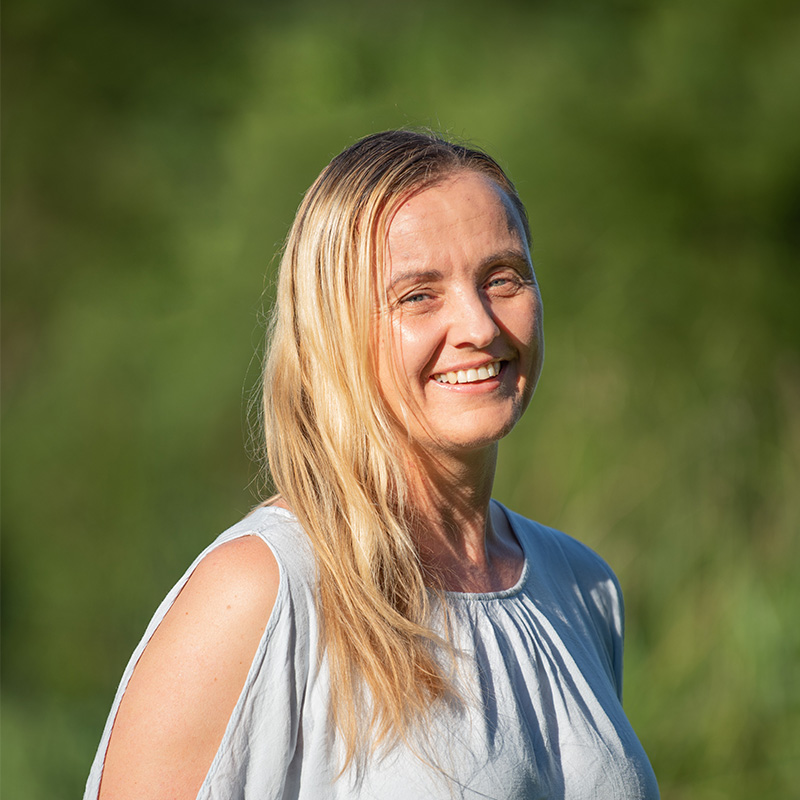Andy Hardy - Choosing His Own Adventure
Old-school spirit. New-school mentality. Meet Andy Hardy.


Victoria’s Andy Hardy wears his enthusiasm on his sleeve. His adventurous nature is evident in not only what he says, but how he says it... with peak energy and full investment. At the same time, you get the sense that whenever there’s a break in conversation, Andy’s mind flicks to the whichever mountain he’s set to climb next, literally, figuratively, or as is often the case, both.
As a multidisciplined filmmaker, Andy and his team traverse documentary, commercials, education and “content creation” – but even that mini-list is reductive. Andy is very much a modern storyteller, realising that the lines between official titles, visual mediums and audience expectations aren’t as clear cut as they once were. Through his production company, Emble, Andy has created for Mini, Hard Yakka and Riparide. And by created we mean created – not just photography, not just filmmaking, but full-service, end-to-end, concept-to-handover branded campaigns.
In an industry that has been softened and simplified by a general population who pick up their smartphone and suddenly become filmmakers, Andy brings an old-school spirit to the new school – operating in modern paradigms but believing in the sanctity of technical knowledge, skills development and creative risk. His videography is lush and cinematic and the perfect antidote to the rise and ruse of slapdash user-generated content.
We managed to get Andy to sit still for long enough to have a bit of chat about filmmaking, his career to date and the Nikon Z 9.
What is your earliest memory of photography having an impact in your life/mind?
It’s funny. My folks got me into it without really knowing it. They got me a little point-and-shoot camera that I took on a year nine excursion to the Hobart jail. I remember using that and thinking: oh, this is pretty cool. It was a film camera, this little analogue dude. They weren’t much back in the day but nowadays that can be pretty sought after.
So, I was using that at the same time I started riding BMX and skating. My folks noticed that and bought me a little power-zoom camera. I used it to take photos of my mates skateboarding and riding. I was also figuring out Photoshop and making posters for skate park jams. That was probably the earliest impact, and it progressed pretty quickly from there into landscapes.
What do you think about that process of shooting your mates skating and riding kept you going back to it? Were you getting good feedback? Was it the actual process you enjoyed?
Growing up riding BMX, one of the magazines we were into was 2020 magazine. I just thought it was so cool and all the photography was of really high quality. I’ve actually still got a bunch of them at home. And that was really important to me because I looked up to a lot of photographers at 2020 and so I was trying to emulate their styles, and learning a lot about composition. A lot of people don’t realise, but these photographers are really talented both compositionally and creatively.
By the time I moved to Melbourne when I was 19 or 20, I actually ended up shooting for 2020 magazine and ended up doing so for many years, which was really cool. When I started doing that I thought: woah, I’ve made it! But that was just the start.
When you mention creative composition of riders, are you referring only to the photographer’s composition, or also the actual logistical composition of the rider/skater’s trick?
The perspective that I’m talking about is actually both. The rider’s being creative and the photographer’s being creative as well, and when you shoot someone that’s doing extreme sport it’s such a collaboration. It’s your ability as a photographer to compose, frame, light, but also their ability to be aware of what they do and communicate it. If they’re going to hit some gap, the ones that know what they’re doing will say something like “oh dude, I’m going to be the highest point at this part of the jump!”
Even now we, at Emble, our production company here in Bright, we shoot all of the snow campaigns for Mt. Buller, Mt. Hotham and Falls Creek – the three main ski resorts in the Victorian Alps. We work with a lot of the same skiers and snowboarders because they understand the process. Especially on a powder day when there’s heaps of snow, you often only get one shot at the shot. You might want them to turn here, or carve past us there. The good ones understand whatever you’re shooting with - that a 16mm is super wide and that they need to basically be touching the camera when they come past you.
That sort of relationship between rider and shooter is really fun. It’s not something you often get with portraits and stuff, where you can help them and tell them what to do in order to look good. When you’re on the edge of the mountain, there’s no time or room for that.
I guess shooting your mates riding BMX when you were younger and learning that process naturally, transferred pretty well to the work you do now?
100%. Even in the film we’ve recently completed, a collaboration with Nikon and Riparide – the climbers need to have a decent understanding of what we’re trying to achieve, of the fact that sometimes we can frame something that might not be as gnarly that looks really cool, or that something that is really gnarly might be hard to compose. And then we have to understand what they’re capable of and what’s dangerous. You both have to work together to figure out what looks the best, and figure out how the pinnacle moment can be captured.


You’ve been a storyteller for Riparide for a while. Can you tell us a bit about that process?
I’ve been shooting accommodations for them on and off for about nine years. They’ll send me out to capture an accommodation as well as three accompanying activities to showcase the adventures you can access while staying there. For this latest collaboration, I basically did what I always do, except with the Nikon Z 9. See how that camera would perform, and as a storyteller and as a photographer shooting adventurous stuff outside of that.
Which Riparide did you stay at while shooting the film for Riparide and Nikon?
Lothlorien. It’s a beautiful tucked-away property on your way into Mt. Beauty. The owners let you roam freely around the gardens, where there’s this oversized chess board, and the ground is covered in this amazing moss that almost doesn’t look real. The hot tub was amazing. The barn-style accommodation was so unique.




When you go out to a unique accommodation and look for unique adventures in the surrounding area, do you previsualise the story you want to tell or figure it out when you get there?
Most of the time you need to have a previsualisation of what you’re going to do because you only have one-to-two days to capture the accommodation and 20 images of the adventures that surround it. Normally about 10 of those images are of the accommodation – rooms, hot tub, whichever features it has. Then the other 10 are of the adventures that you do. If you’re shooting film footage, you try to wrap all of that up into the same piece.
Though with our recent film, we utilised the accommodation as a jumping ground for something that was really going to put the features of the Nikon Z 9 to the test. To capture the breadth of the Z 9 we, of course, captured all of the still images of the accommodation, and then the video focused more on the adventures.
On a personal level, how do you get creative fulfillment through gigs like these?
With the Riparide stories, they never really feel like work, in a way. You’re getting to go and shoot this accommodation and given free rein to find adventures that surround it. I’m always looking for Riparides that give me access to the things I love to do, and that I want to take photos of. Mountain biking, snowboarding, hiking – adventuring! Within those three adventures for each property, you might choose two outdoor adventures and one café or restaurant that you got yummy eats from while you were there. So, for me, it’s always fun to find out that Riparide that will allow me to go on those adventures, and more importantly, capture them in a way I hopefully haven’t done before.


You’ve said in your personal showreel that help your clients find the ‘why’ behind what they do. What’s your ‘why’?
I’ve worked with a number of artists, content creators and corporate photographers. Doing these documentary bios for people where you’re finding out that person’s ‘why’, helped me discover my ‘why’ more – which I think is around curiosity over people’s stories and really understanding what drives them, what little piece inside drives them to do something really unique. And my little unique thing is to tell their stories, share their stories in a way that might be really hard to do otherwise.
What you’re describing to me sounds like the heart of a documentarian – the desire to understand what truly drives people, even if it’s not always clear from the outset.
Yeah, definitely. Before transitioning into filmmaking, I majored in photojournalism in my final year at photography school. I had such awesome tutors. I had an Australian Geographic photographer and a National Geographic photographer. Those were my two mentors for that final year. That really helped me understand the documentary process. And to understand the importance of knowing the difference between when you’re consciously shaping a story or being a true documentarian. A lot of people get confused by the line between the two.
Essentially, we’re talking about the line between scripted and unscripted, yeah?
Yeah.
I think with social media, that line’s becoming increasingly blurred. Passing off fake things as real and people jumping to call real things as fake. It’s hard to find stuff that’s genuine and honest.
One thing we’re finding is that the performance of “user-generated content” (UGC) performs so much better than beautifully produced content, with compelling stories, shot on 8K cameras and with beautiful lighting. You see these iPhone videos popping off with millions of views. I think that’s really dangerous, in a way. People are seeing UGC and thinking: oh, it can get the views and the traction because people think it’s real because it’s been shot on an iPhone. Now, brands and companies are realising that; brands and companies that definitely have access to millions of dollars of filmmaking equipment are instead of using that equipment, shooting on an iPhone.
Many consumers are looking at that and going: I can trust that person, they’re just like me. They’ve shot themselves on an iPhone. I can do a selfie video! They’re talking to me! Most of the time that’s not the case. Brands have just cottoned onto it. It’s shaken up the industry.
We're lucky enough at Emble to work with brands that realise the importance of high-quality content and how it elevates your brand.
Are those brands interested in high-quality production values because their audience may be outside the Tik Tok-sphere?
Yeah, definitely. We work with brands like Arc-teryx to create outdoor content. High-end outdoor gear. They have a premium feel to their clothing. They’re expensive, but when you try on one of their jackets you can tell why they cost that much. It’s made of the most waterproof thing you can put on your body.
We work with brands like Arc’teryx or Mini, or even with Hard Yakka or King Gee, and I guess higher-level brands understand the importance of higher-level content.
The flip side of that is that high-end gear is cheaper than ever and it’s easier than ever to produce a high-quality image. How do you separate yourself from the pack, with that increased competition?
I’m just going to go off on a quick tangent because you mentioned that high-quality filming gear is becoming more affordable. Up until the Z 9, if you wanted to capture 8K RAW video, you’re looking at a $30-40K camera. The advantage of the Z 9 isn’t only that it’s affordable, it’s its size. Yeah, it’s a little bigger than a single-grip Mirrorless camera, it’s dual-grip, it’s shaped like a pro-DSLR. But you can take it five-six hours into the back country to shoot skiing or be out in the rain on top of Mt. Buffalo, or whatever it is. It’s compact and can shoot that high-resolution video. Alternative cameras with similar specs are not only five times more expensive but five times bigger and heavier.


Apart from the size and convenience, is there anything about the Z 9 that has piqued your interest?
The first feature that comes to mind, that I wish I had before… I mean, I don’t need it as much now because I work in a lot more controlled lighting scenarios, but when I was shooting a lot of weddings, I wish I had this feature.
…actually, I’ll give you an example. We were on a Hard Yakka worksite, and we were using our lights to light and film this image, but the worksite had this big floodlight on in the background. The power refresh rate of that floodlight was causing this gnarly shutter. You were getting the kinds of streaks or bands through the images that I’m sure many photographers and especially filmmakers have experienced before.
Having a feature that lets you avoid that stuff is a no-brainer and I don’t know why every camera doesn’t have it. I think it’s going to solve a lot of issues for filmmakers.
From what I’m hearing and understand, you do a lot of adventure shooting. Random question, but does with those kinds of projects, does fitness come into play at all?
[Laughing] yeah, definitely.
Honestly!
Yeah! I mean… I’m not the fittest guy going around, I don’t go to the gym or anything. But I think because I’m so active, walking to spots, or mountain biking…
When we’re here in Bright and not on commercials, I would say the amount of work we do is 50% adventure and 50% commercial stuff. Our ideal scenario is to be shooting out here 75% of the time. Shooting adventure content, pre-producing and planning for commercials we go to Melbourne for, mountain biking and snowboarding. Over the winter, I snowboarded for 40-something days, then in other periods, mountain biking on pretty much most days of the week, if the weather’s good.
I can ride from my front door to the best mountain bike parks in Victoria. At Mystic Park you get about, I think, 700m vertical descent? I’m riding up and down that every day, that’s my fitness. That’s my gym. Pedals and a dual-suspension mountain bike.
How would you define the term ‘content creator’, these days?
That’s a really funny question because on one hand, it feels like every man and his dog is a content creator, and then on the other hand, sometimes we slide into that department. But we don’t ever really market or think of ourselves as content creators. We’re filmmakers. We’re a production company that creates high-quality content for brands that want to connect better with an audience.
So, that’s our thing. We’re not really even just photographers or filmmakers anymore. We’re creative directors, strategists...
I think the lines have been blurred so much that —and I’m not saying this is right at all—you’d even have some more traditional narrative or doco filmmakers argue that any kind of content creator is not a filmmaker…
Totally. I think on one hand, yes, we do create content for brands and some of it ends up on social media. So, are we content creators? Maybe. But at the same time, I think that the work we produce is of a high-quality and we pay a lot of attention to the story, and in outputs that are beautifully crafted.
So, I push myself away from the term content creator, but we definitely do some content creation for brands. But when I think about the difference between content creator and filmmaker who happens to in part, create content – there are 100 million content creators on Instagram making or trying to make a living, you know, shooting themselves in different outfits or using different products for different brands… all in vertical videos…
Does that kind of thing, because you’ve developed the skills and worked so hard and put so much thought into making what you make… does it kind of bum you out a bit? Seeing that lazy, anyone-can-do-it-without-effort approach to content creation?
Hah, I thought you were talking about vertical video then.
Well, even that. That’s part of it.
Well, are you asking me if it bums me out if 4/5ths of my image is cut down to [narrows the palms of his hands to signify shrinking distance] this? Yeah, it [redacted] bums me out. It’s [redacted].
But look, I now think there’s a time and a place for both, and I’m now probably slightly more excited about vertical video, when you know that’s actually what you’re going to create, and it’s not a deliverable you’ve been asked to create AFTER you’ve created some beautiful landscape piece. If you know the limitations going in then I think you can get really creative.
Portrait framing is a new challenge. And something else that was cool about the Z 9 is the usability of the vertical grip. I’ve actually changed the shutter button when in video mode to start shooting, so I’m able to shoot awesome reel content when in vertical, by actually thinking about how its composed in the vertical. That excites me a little bit. Not amazingly, but a little bit. It’s a fun challenge.




If you could offer three tips for those who want to get into videography or content-based filmmaking, what would you say?
The first one, I’d say, is invest in projects and on yourself and not just in the latest camera gear, because if you already have a great camera and lens that captures great images and video, then invest in creating new stuff. That might be spending $1000 on going on a trip, or on that road trip adventure. Those investments have shot-gunned my career just as much as any gear purchase.
Second one would be always be learning. Always look for new things. Even with what we’re doing now, we’re always watching YouTube videos, still doing colour-grading courses, always levelling up. The moment you think you know everything, that’s when you stop progressing.
My last tip is very controversial. People will either love it or hate it. I throw away all of my lens caps. My business partners and some of my shooters hate it. When I was studying photojournalism, our tutor (National Geographic photographer Michael Coyne – really amazing documentarian, shot many war zones, really gnarly dude) said “anyone in the class, raise your hand if you have got your lens cap on”. And everyone raised their hands. Then he went over to the corner and grabbed the bin and pulled it over to the middle of the room and said “I want all you guys to throw your lens caps in the bin”.
This is Dead Poets Society! Have you ever seen it? Robin Williams grabs the bin and tells the students to rip out the didactic front page of their poetry books?
Oh yeah! He did it in a classic Dead Poets Society-style. I didn’t even think about that at the time. We were like “what do you mean?”
He argued that if you really wanted to protect your lens, to go out and buy a UV filter or something, because if you want to be a real documentary photographer, every lens cap is one more thing between you and capturing the moment.
And imagine the amounts of moments you’ve missed because you’ve picked up your camera to shoot, messed with the exposure, trying to figure out why the image is black – or you’re looking through a rangefinder and you actually go and shoot and then you realise the lens cap is on and you’ve missed that image. Now, imagine you’re a photographer for the rest of your life, how many moments are you going to miss over your entire career?
That’s cool. I like it. And looking at the future, is there anything you’ve been itching to branch out into?
I’ve been really fortunate that I’ve been able to shape my work into what I enjoy doing. I really enjoy working with brands that want the kinds of content that we want to create. They really give us the creative onus. I don’t so much think about selling a product, but more that people buy something from a brand because they want it or need it, I really enjoy working with brands that are need-based. I align with them.
But in the future, we have big goals of creating more short films. We’re working on a short film at the moment that we hope will come together.
As in scripted? Not commercial or ad-based?
Yep scripted. We have a concept going to have sponsors come in to help support it. It’s a personal project but sponsors could actually help us execute it.
Interesting. But it’s a story, with characters?
It’s a story, with characters. We’re hoping to shoot it over summer. Let’s see what happens with that – it’s a big goal. Keep an eye on Emble studio on Instagram or the web.
Do exactly that by visiting Emble on the web or on Instagram. Browse Andy’s personal page here, or his Instagram here.





